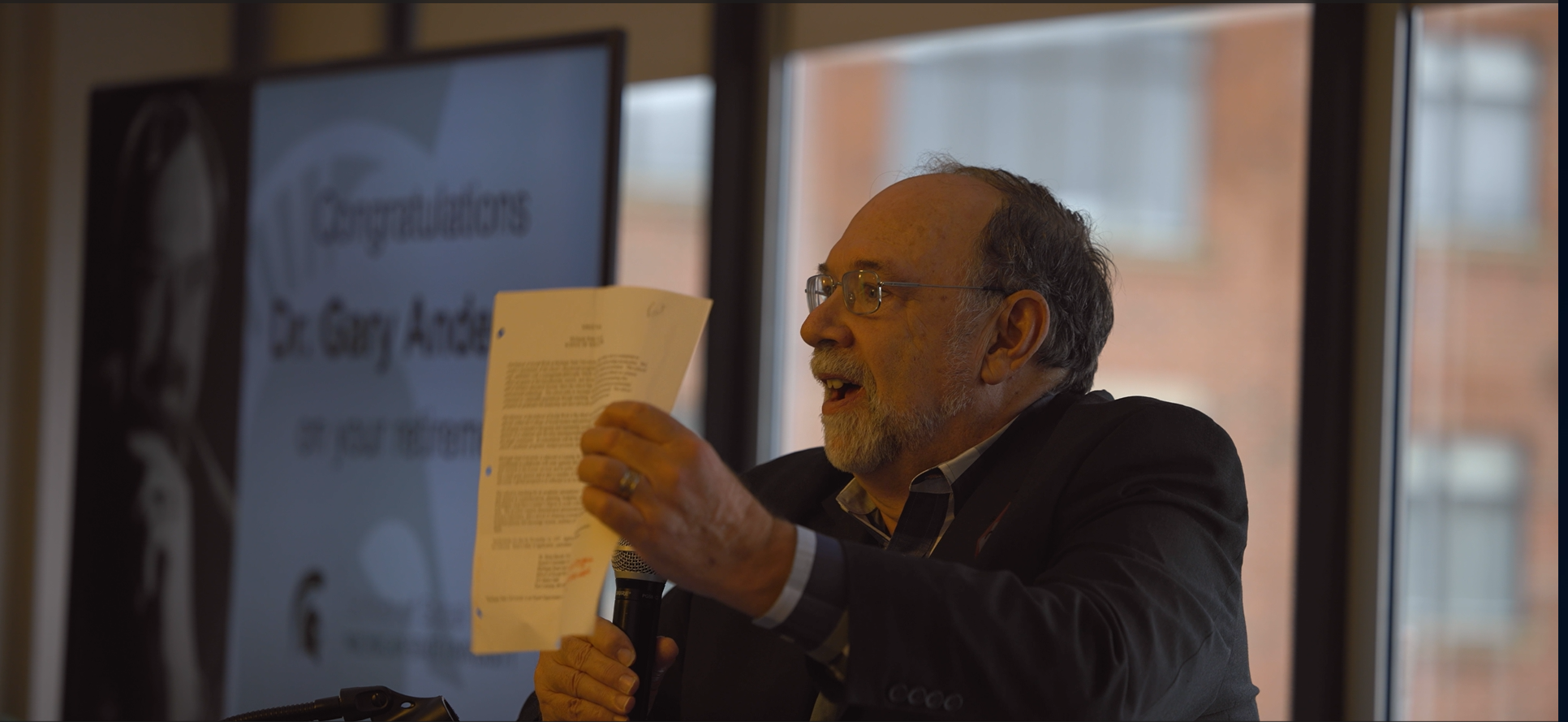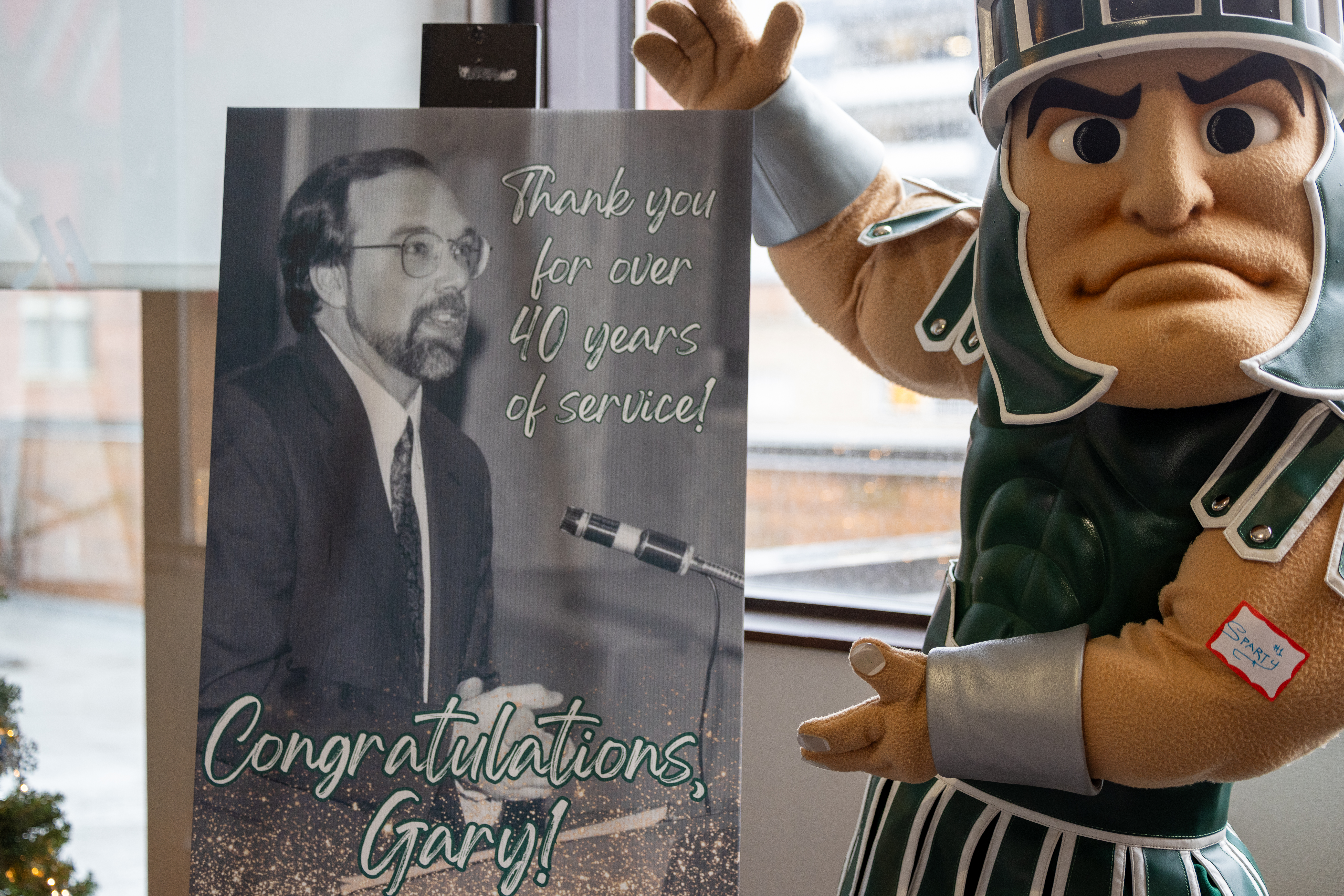Reflecting on the legacy of MSU School of Social Work Professor Gary Anderson
February 27, 2024 - Brandon Drain
Gary Anderson served at the MSU School of Social Work for 25 years; 15 years as its director and another 10 years as a faculty member. Anderson developed and supported many innovative programs and projects, like the Community Programs, which continue today and allow the school to fulfill its service mission across the State of Michigan.
During his 15th year working as a professor at Hunter College School of Social Work in New York City, New York, in early 1998, the then 45-year-old Gary Anderson noticed a one-page printed job announcement for the Director’s position at the Michigan State University School of Social Work. It was pinned to a hallway bulletin board on the seventh floor of the 12-story building.

His father was an MSU graduate, so after reading over its contents a few times, Anderson was curious. He was interested enough that he unpinned the application and took it for himself to study and show his family; an announcement Anderson still keeps as a memento today.
A few weeks later, and a few conference calls after that, the course of Michigan State University’s School of Social Work, as well as Anderson’s life, significantly changed. The school not only found its new director, but it also ushered in a new era of innovation, program development, teamwork and set new precedents for the field of social work as a whole.
Anderson’s journey towards becoming a social work leader, both in the academic space and the practical child welfare space, began with tragedy. At the age of 16, being the oldest of four, Anderson’s mother died due to metastatic cancer. His world and foundation of support was shaken up. “I was a wreck; I had no idea what to do,” Anderson said. “I thought there's got to be people out there. There has to be someone who knows what to do when things are this bad and sad. Is there someone outside your family who can come alongside you, even if just for a little while, and be helpful?”
Those trying times would spur Anderson towards getting the help he so desperately needed as a teenager. He started his career in the child welfare workforce space as a child protective services case worker. In this role, Anderson would immerse himself in the “hardest situations a social worker can be in.” Through often unannounced home visits, talking to parents and meeting with at-risk children, as a social worker, he tried to envision a brighter future for the families, if they were provided support. It was a tough job that is oftentimes “thankless,” Anderson expressed. Yet, one that aimed to preserve and protect the wellbeing of children and families across the state.

Anderson’s roots as a social worker lay in his passion to promote a prosperous future for at-risk children and their families. In his role as director for the School of Social Work, he systematically turned this passion into a working reality. Being in the academic space posed a strong dichotomy for Anderson. As an academic institution, the school had an obligation and the opportunity to consistently fund, focus on and disseminate new research related to the field of social work and its components. This could mean less time spent on the front lines of the community at large, and more time operating in a research-focused, academic capacity. While this endeavor was crucial to the school and its positive mission – as the research can help to create new practices and develop new means of understanding the community and its issues – the need for and value of community engagement also needed attention and resources. “Social work, for me was an action-oriented approach to helping people and communities,” Anderson said. “It's a profession as well as an academic discipline.” The school’s special purpose was to combine this commitment to academic and research excellence and making a difference in the community.
With this focus in mind, Anderson, alongside his colleagues, team and key partners, went on to found and develop the MSU School of Social Work Community Programs. The Community Programs initiative created and embedded four different organizations in the school: The FAME Program (to support MSU students with lived experience in the foster care system), Chance at Childhood (to prepare social work and law students together to better serve children and families), Kinship Care Resource Center (to support family members raising at-risk children) and Continuing Education. These programs collectively aimed to create pathways for people to access the resources they needed to be successful and supported. These programs acted as social work agencies within the school and helped to bridge the gap between being an academic institution, and acting as the on-the-ground, action-oriented resource hub that Anderson and his team envisioned. “These are all things that key partners and colleagues invested in, and that mattered to me,” Anderson said. “We were the only school of social work in the United States that had programs like this; it's like running an agency. So, we've got an academic program, and then we've got four agencies as an important part of our School at the same time.”

The Community Programs have become a defining pillar of the School of Social Work as a whole and continue to strive towards the goal of being a service to the community. They each operate in different, yet overlapping areas, to best support as much of the community as possible. The foster care community with the FAME Program; the protection of children in Chance at Childhood; resources for kinship families and children in the Kinship Care Resource Center; and Continuing Education Program to vastly support professional development and social work education.
This multitiered, agency-like approach was part of Anderson’s vision to galvanize every working member of the school towards action and contribution. “One thing I'm proud of is an ethic or a value that says, ‘There's so many different ways to contribute to the school, to students, to the profession and the community,’” Anderson said. “And each person does something of value to make that happen. So, the community programs don’t hang out there by themselves. They're an integral part of the school – the people who run them and work in them are crucial leaders within the school.”
“His legacy endures in our focus on improving the child welfare workforce, whether in training first line workers, leaders, or policy advocates,” said Anne Hughes, the School’s current director. “His impact on the child welfare field nationally has been tremendous. We hope to honor his legacy by continuing his pioneering work.”
Anderson and his team successfully led over 75 eternally funded grants to provide funds for School projects including support for student scholarships, building the child welfare workforce and programs to support adoptive and kinship families. During his directorship, the school also added over five million dollars to its endowment to increase financial aid for students, promote advocacy and support faculty research. He also co-authored several books and articles describing program evaluation, leadership and workforce development.
Anderson also had a passion for other people’s passions. He would often give his colleagues the freedom and resources to pursue their ideas – no matter how wild they were initially seen to be. One such idea was the formation of a one-of-a-kind online course called "Surviving the Coming Zombie Apocalypse – Catastrophes and Human Behavior". This course, designed and taught by School of Social Work instructor Glenn Stutzky, was intended to learn how human behavior and nature change after a catastrophic event. The online class became one of the most popular courses at Michigan State University, with over 100 students enrolling in it each semester.
This amazing idea for a class, which was inspired by the website of the US Center for Disease Control’s Office of Public Health Preparedness and Response, got its wings from a conversation between Anderson and Stutzky. “I was smart enough to give him some time to be creative,” Anderson said. “He went wild, and made up this bizarre, wonderful class. And it took off like mad. And everybody really kind of grew from that experience.”
As director, Anderson was known for his supportive nature to faculty, staff and students. He made it his mission to let colleagues within the school know that he was in their corner and appreciated their contributions, no matter how modest it might seem. Anderson spent countless hours reading faculty reviews from students and would write letters to faculty echoing the positive sentiments from those they taught. The positive quality of teaching and the student experience were crucial goals for the school.
Known for his nature as “an optimist and believer in making what seems impossible, possible,” said Beth Lindley, director KCRC, Anderson attributes his success as director and as a professor to his valuing relationships such as his colleagues within the school and partnerships outside of the school.
“In every relationship, I'm learning something,” Anderson said. “Investing in relationships pays off. And social work is a relationship business. I know that so much of the school’s success was due to relationships across campus, across the community and across the country.”
As Anderson ends his 25-year tenure with the school, his impact and legacy will continue to live on through each person he’s touched and every community he’s helped build. “He was a great leader and colleague,” said Anne Hughes. “His lasting impact endures in our collegiality, the care we provide our students and the deep appreciation of the power of social work to make meaningful change.”

